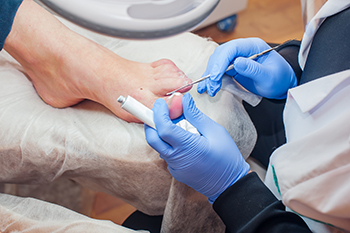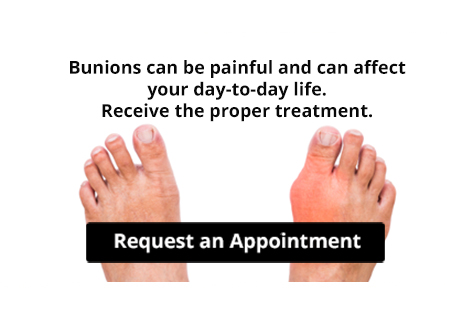Blog
Did I Break My Ankle?
 The ankle is a joint that connects leg bones (the tibia and fibula) with a foot bone (talus), providing up-and-down movement, stability, and shock absorption for the foot. Ankle fractures typically occur when either or both of these leg bones break. Fractures are characterized as either stable (if talus moves normally), or unstable (if talus moves abnormally). To the average person, it can be hard to tell whether they are experiencing an ankle fracture or an ankle sprain—which occurs when the ligaments on the ankle are damaged. Some telltale signs of a fracture can be: a cracking sound when the injury occurs, numbness or tingling, pain over the ankle bone, or even a misshapen ankle. While both ailments are painful, an ankle fracture is much more serious. Consult with a podiatrist who will be able to diagnose the injury properly and provide necessary treatment.
The ankle is a joint that connects leg bones (the tibia and fibula) with a foot bone (talus), providing up-and-down movement, stability, and shock absorption for the foot. Ankle fractures typically occur when either or both of these leg bones break. Fractures are characterized as either stable (if talus moves normally), or unstable (if talus moves abnormally). To the average person, it can be hard to tell whether they are experiencing an ankle fracture or an ankle sprain—which occurs when the ligaments on the ankle are damaged. Some telltale signs of a fracture can be: a cracking sound when the injury occurs, numbness or tingling, pain over the ankle bone, or even a misshapen ankle. While both ailments are painful, an ankle fracture is much more serious. Consult with a podiatrist who will be able to diagnose the injury properly and provide necessary treatment.
Broken ankles need immediate treatment. If you are seeking treatment, contact Shaun J. Limon, DPM and Lisa Griffith-Limon, DPM from Limons Foot & Ankle Care. Our doctors can provide the care you need to keep you pain-free and on your feet.
Broken Ankles
A broken ankle is experienced when a person fractures their tibia or fibula in the lower leg and ankle area. Both of these bones are attached at the bottom of the leg and combine to form what we know to be our ankle.
When a physician is referring to a break of the ankle, he or she is usually referring to a break in the area where the tibia and fibula are joined to create our ankle joint. Ankles are more prone to fractures because the ankle is an area that suffers a lot of pressure and stress. There are some obvious signs when a person experiences a fractured ankle, and the following symptoms may be present.
Symptoms of a Fractured Ankle
- Excessive pain when the area is touched or when any pressure is placed on the ankle
- Swelling around the area
- Bruising of the area
- Area appears to be deformed
If you suspect an ankle fracture, it is recommended to seek treatment as soon as possible. The sooner you have your podiatrist diagnose the fracture, the quicker you’ll be on the way towards recovery.
If you have any questions, please feel free to contact our offices located in Bradenton and Lakewood Ranch, FL . We offer the newest diagnostic and treatment technologies for all your foot care needs.
Read more about All About Broken AnkleDiabetic Foot Wounds May Heal Slowly
Diabetic foot wounds are chronic ulcers that may appear on the feet of people who have diabetes. Because these wounds heal slowly and poorly, and often become infected, diabetic foot ulcers are a major cause of lower limb amputations. Preventing these wounds from occurring in the first place continues to be an important goal for maintaining the overall health of people with diabetes. You can help prevent wounds by practicing good foot hygiene and wearing shoes and socks when you are on your feet. Performing daily foot inspections, in which you check your feet for any abnormalities—such as cuts, scrapes, sores, discoloration, and pain or strange sensations—can help detect problems early on and improve treatment outcomes. For more information about diabetic foot health, please consult with a podiatrist.
Wound care is an important part in dealing with diabetes. If you have diabetes and a foot wound or would like more information about wound care for diabetics, consult with Shaun J. Limon, DPM and Lisa Griffith-Limon, DPM from Limons Foot & Ankle Care. Our doctors will assess your condition and provide you with quality foot and ankle treatment.
What Is Wound Care?
Wound care is the practice of taking proper care of a wound. This can range from the smallest to the largest of wounds. While everyone can benefit from proper wound care, it is much more important for diabetics. Diabetics often suffer from poor blood circulation which causes wounds to heal much slower than they would in a non-diabetic.
What Is the Importance of Wound Care?
While it may not seem apparent with small ulcers on the foot, for diabetics, any size ulcer can become infected. Diabetics often also suffer from neuropathy, or nerve loss. This means they might not even feel when they have an ulcer on their foot. If the wound becomes severely infected, amputation may be necessary. Therefore, it is of the upmost importance to properly care for any and all foot wounds.
How to Care for Wounds
The best way to care for foot wounds is to prevent them. For diabetics, this means daily inspections of the feet for any signs of abnormalities or ulcers. It is also recommended to see a podiatrist several times a year for a foot inspection. If you do have an ulcer, run the wound under water to clear dirt from the wound; then apply antibiotic ointment to the wound and cover with a bandage. Bandages should be changed daily and keeping pressure off the wound is smart. It is advised to see a podiatrist, who can keep an eye on it.
If you have any questions, please feel free to contact our office located in Lakewood Ranch, FL . We offer the newest diagnostic and treatment technologies for all your foot care needs.
Gout Pain Can Be Managed
Is My Foot Sprained or Broken?
 Sometimes it can be difficult to tell the difference between a sprain and a foot fracture. Both injuries have very similar symptoms, including pain, swelling, and bruising. A fracture will often be so painful that you may not be able to walk. Sprains can also make walking difficult, depending on the severity of the injury. At the time that you injure your foot, you may hear a noise. A popping sound can indicate a sprain, while a cracking sound can indicate a fracture. Treatments for the two conditions are different, so it is important to get a proper diagnosis. If you have injured your foot, it is suggested that you see a podiatrist as soon as possible.
Sometimes it can be difficult to tell the difference between a sprain and a foot fracture. Both injuries have very similar symptoms, including pain, swelling, and bruising. A fracture will often be so painful that you may not be able to walk. Sprains can also make walking difficult, depending on the severity of the injury. At the time that you injure your foot, you may hear a noise. A popping sound can indicate a sprain, while a cracking sound can indicate a fracture. Treatments for the two conditions are different, so it is important to get a proper diagnosis. If you have injured your foot, it is suggested that you see a podiatrist as soon as possible.
A broken foot requires immediate medical attention and treatment. If you need your feet checked, contact Shaun J. Limon, DPM and Lisa Griffith-Limon, DPM from Limons Foot & Ankle Care. Our doctors can provide the care you need to keep you pain-free and on your feet.
Broken Foot Causes, Symptoms, and Treatment
A broken foot is caused by one of the bones in the foot typically breaking when bended, crushed, or stretched beyond its natural capabilities. Usually the location of the fracture indicates how the break occurred, whether it was through an object, fall, or any other type of injury.
Common Symptoms of Broken Feet:
- Bruising
- Pain
- Redness
- Swelling
- Blue in color
- Numbness
- Cold
- Misshapen
- Cuts
- Deformities
Those that suspect they have a broken foot shoot seek urgent medical attention where a medical professional could diagnose the severity.
Treatment for broken bones varies depending on the cause, severity and location. Some will require the use of splints, casts or crutches while others could even involve surgery to repair the broken bones. Personal care includes the use of ice and keeping the foot stabilized and elevated.
If you have any questions please feel free to contact our office located in Lakewood Ranch, FL . We offer the newest diagnostic and treatment technologies for all your foot and ankle needs.
Why Has My Toenail Turned Black?
 A toenail that has turned black, whether suddenly or gradually, can be an alarming sight. Sometimes, a toenail may turn black following repetitive injuries to the nail. In many cases, the nail can grow out naturally, but in more severe cases when the nail begins to lift off of the nail bed, medical attention will be required. A one-time blunt force injury, like dropping a heavy piece of furniture on your toes, can also turn your toenail black and often causes pain and swelling. Fungal nail infections typically cause toenails to turn white or yellow, but as debris builds up near the infection, the toenail can also turn black. Natural changes in pigmentation that can occur with age may turn the nails darker in people with darker skin. Other potential causes of black toenails include melanoma, and underlying medical conditions such as diabetes, kidney disease, heart disease, and anemia. If you notice a change in the color of your toenails, it is suggested that you seek the care of a podiatrist.
A toenail that has turned black, whether suddenly or gradually, can be an alarming sight. Sometimes, a toenail may turn black following repetitive injuries to the nail. In many cases, the nail can grow out naturally, but in more severe cases when the nail begins to lift off of the nail bed, medical attention will be required. A one-time blunt force injury, like dropping a heavy piece of furniture on your toes, can also turn your toenail black and often causes pain and swelling. Fungal nail infections typically cause toenails to turn white or yellow, but as debris builds up near the infection, the toenail can also turn black. Natural changes in pigmentation that can occur with age may turn the nails darker in people with darker skin. Other potential causes of black toenails include melanoma, and underlying medical conditions such as diabetes, kidney disease, heart disease, and anemia. If you notice a change in the color of your toenails, it is suggested that you seek the care of a podiatrist.
For more information about treatment, contact Shaun J. Limon, DPM and Lisa Griffith-Limon, DPM of Limons Foot & Ankle Care. Our doctors can provide the care you need to keep you pain-free and on your feet.
Toenail Fungus Treatment
Toenail fungus is a condition that affects many people and can be especially hard to get rid of. Fortunately, there are several methods to go about treating and avoiding it.
Antifungals & Deterrence
Oral antifungal medicine has been shown to be effective in many cases. It is important to consult with a podiatrist to determine the proper regiment for you, or potentially explore other options.
Applying foot powder on the feet and shoes helps keep the feet free of moisture and sweat.
Sandals or open toed shoes – Wearing these will allow air movement and help keep feet dry. They also expose your feet to light, which fungus cannot tolerate. Socks with moisture wicking material also help as well.
If you have any questions please feel free to contact our offices located in Bradenton and Lakewood Ranch, FL . We offer the newest diagnostic tools and technology to treat your foot and ankle needs.
Read more about How to Treat Your Toenail FungusAre Bunions Affecting Your Everyday Life?
Plantar Fasciitis Stretching Tips
 The plantar fascia is a portion of tissue that is found on the sole of the foot. Its function is to connect the heel to the toes, and it is instrumental in walking and completing daily activities. Plantar fasciitis occurs when this band of tissue becomes inflamed, causing difficulty walking, running, and doing other activities. There are simple stretches and exercises that may help to relieve part of the pain that often accompanies plantar fasciitis. Many patients find it helpful to stand on a step, and gently lower one heel at a time until a stretch is felt. Additionally, it is beneficial to push against a wall while keeping the back leg straight, as this can help stretch the Achilles tendon which is connected to the heel. Please consult with a podiatrist if you would like more information about how to perform efficient stretches for plantar fasciitis.
The plantar fascia is a portion of tissue that is found on the sole of the foot. Its function is to connect the heel to the toes, and it is instrumental in walking and completing daily activities. Plantar fasciitis occurs when this band of tissue becomes inflamed, causing difficulty walking, running, and doing other activities. There are simple stretches and exercises that may help to relieve part of the pain that often accompanies plantar fasciitis. Many patients find it helpful to stand on a step, and gently lower one heel at a time until a stretch is felt. Additionally, it is beneficial to push against a wall while keeping the back leg straight, as this can help stretch the Achilles tendon which is connected to the heel. Please consult with a podiatrist if you would like more information about how to perform efficient stretches for plantar fasciitis.
Stretching the feet is a great way to prevent injuries. If you have any concerns with your feet consult with Shaun J. Limon, DPM and Lisa Griffith-Limon, DPM from Limons Foot & Ankle Care. Our doctors will assess your condition and provide you with quality foot and ankle treatment.
Stretching the Feet
Stretching the muscles in the foot is an important part in any physical activity. Feet that are tight can lead to less flexibility and make you more prone to injury. One of the most common forms of foot pain, plantar fasciitis, can be stretched out to help ease the pain. Stretching can not only ease pain from plantar fasciitis but also prevent it as well. However, it is important to see a podiatrist first if stretching is right for you. Podiatrists can also recommend other ways to stretch your feet. Once you know whether stretching is right for you, here are some excellent stretches you can do.
- Using a foam roller or any cylindrical object (a water bottle or soda can will do), roll the object under your foot back and forth. You should also exert pressure on the object. Be sure to do this to both feet for a minute. Do this exercise three times each.
- Similar to the previous one, take a ball, such as a tennis ball, and roll it under your foot while seated and exert pressure on it.
- Grab a resistance band or towel and take a seat. If you are using a towel, fold it length wise. Next put either one between the ball of your foot and heel and pull with both hands on each side towards you. Hold this for 15 seconds and then switch feet. Do this three times for each foot.
- Finally hold your big toe while crossing one leg over the other. Pull the toe towards you and hold for 15 seconds. Once again do this three times per foot.
It is best to go easy when first stretching your foot and work your way up. If your foot starts hurting, stop exercising and ice and rest the foot. It is advised to then see a podiatrist for help.
If you have any questions, please feel free to contact our offices located in Bradenton and Lakewood Ranch, FL . We offer the newest diagnostic and treatment technologies for all your foot care needs.
Read more about How to Stretch Your FeetChildren and Orthotics
 A common reason orthotics are worn is to provide stability, balance, and proper foot function. Orthotics are custom-made insoles that can provide the necessary adjustments to the structure of the feet. Orthotics can help children to develop and maintain a normal walking style, and can aid in improving conditions such as flat feet, toe walking, and general foot weakness. It may be easier for children with these ailments to accomplish everyday walking, running, and jumping activities when orthotics are worn. If you would like additional information about orthotics, and to find out if they are right for your child, it is suggested that you schedule a consultation with a podiatrist.
A common reason orthotics are worn is to provide stability, balance, and proper foot function. Orthotics are custom-made insoles that can provide the necessary adjustments to the structure of the feet. Orthotics can help children to develop and maintain a normal walking style, and can aid in improving conditions such as flat feet, toe walking, and general foot weakness. It may be easier for children with these ailments to accomplish everyday walking, running, and jumping activities when orthotics are worn. If you would like additional information about orthotics, and to find out if they are right for your child, it is suggested that you schedule a consultation with a podiatrist.
Making sure that your children maintain good foot health is very important as they grow. If you have any questions, contact Shaun J. Limon, DPM and Lisa Griffith-Limon, DPM of Limons Foot & Ankle Care. Our doctors can provide the care you need to keep you pain-free and on your feet.
Keeping Children's Feet Healthy
Having healthy feet during childhood can help prevent medical problems later in life, namely in the back and legs. As children grow, their feet require different types of care. Here are some things to consider...
Although babies do not walk yet, it is still very important to take care of their feet.
Avoid putting tight shoes or socks on his or her feet.
Allow the baby to stretch and kick his or her feet to feel comfortable.
As a toddler, kids are now on the move and begin to develop differently. At this age, toddlers are getting a feel for walking, so don’t be alarmed if your toddler is unsteady or ‘walks funny’.
As your child gets older, it is important to teach them how to take care of their feet.
Show them proper hygiene to prevent infections such as fungus.
Be watchful for any pain or injury.
Have all injuries checked by a doctor as soon as possible.
Comfortable, protective shoes should always be worn, especially at play.
If you have any questions please feel free to contact our offices located in Bradenton and Lakewood Ranch, FL . We offer the newest diagnostic and treatment technologies for all your foot and ankle needs.
Read more about What to Do to Keep Your Child’s Feet HealthyAre You Suffering From Ingrown Toenails?
Can Falling Be Prevented?
 Falling can be a devastating experience and may cause pain and discomfort. For people who are over sixty-five years of age, falling can hinder their health and independence. Injuries such as broken toes and ankles can be common if falling occurs. There are methods that can be implemented that can help to prevent falling. These tips may include improving the lighting in the household, in addition to having existing medications reviewed by having regular examinations. It can be beneficial to perform stretching and toning exercises in order to help maintain strength in the body. Many patients find falling episodes can be reduced when grab bars are installed in the shower and the toilet area, and bath mats are used while bathing. If you would like more information about how falling can affect the feet, and would like to learn more about preventative methods, please consult with a podiatrist.
Falling can be a devastating experience and may cause pain and discomfort. For people who are over sixty-five years of age, falling can hinder their health and independence. Injuries such as broken toes and ankles can be common if falling occurs. There are methods that can be implemented that can help to prevent falling. These tips may include improving the lighting in the household, in addition to having existing medications reviewed by having regular examinations. It can be beneficial to perform stretching and toning exercises in order to help maintain strength in the body. Many patients find falling episodes can be reduced when grab bars are installed in the shower and the toilet area, and bath mats are used while bathing. If you would like more information about how falling can affect the feet, and would like to learn more about preventative methods, please consult with a podiatrist.
Preventing falls among the elderly is very important. If you are older and have fallen or fear that you are prone to falling, consult with Shaun J. Limon, DPM and Lisa Griffith-Limon, DPM from Limons Foot & Ankle Care. Our doctors will assess your condition and provide you with quality advice and care.
Every 11 seconds, an elderly American is being treated in an emergency room for a fall related injury. Falls are the leading cause of head and hip injuries for those 65 and older. Due to decreases in strength, balance, senses, and lack of awareness, elderly persons are very susceptible to falling. Thankfully, there are a number of things older persons can do to prevent falls.
How to Prevent Falls
Some effective methods that older persons can do to prevent falls include:
- Enrolling in strength and balance exercise program to increase balance and strength
- Periodically having your sight and hearing checked
- Discuss any medications you have with a doctor to see if it increases the risk of falling
- Clearing the house of falling hazards and installing devices like grab bars and railings
- Utilizing a walker or cane
- Wearing shoes that provide good support and cushioning
- Talking to family members about falling and increasing awareness
Falling can be a traumatic and embarrassing experience for elderly persons; this can make them less willing to leave the house, and less willing to talk to someone about their fears of falling. Doing such things, however, will increase the likelihood of tripping or losing one’s balance. Knowing the causes of falling and how to prevent them is the best way to mitigate the risk of serious injury.
If you have any questions, please feel free to contact our offices located in Bradenton and Lakewood Ranch, FL . We offer the newest diagnostic and treatment technologies for all your foot care needs.
Read more about Falls PreventionMore...
Exercising After a Foot or Leg Injury
A foot or leg injury could upend your workout plans. Fortunately, you can still work out even with an injury, so long as you are careful in the selection of your exercises and mindful of your injury. If you have injured your foot or leg, you can still do many strength and resistance training exercises in a seated position. If you have injured only one leg, you can also still exercise the non-injured leg by doing balancing exercises and leg lifts. Once your injury has begun to heal, low impact workouts like swimming, hiking, walking, cycling, and yoga can all help your transition back into your regular exercise routine. Prior to starting any workouts following a foot or leg injury, it is suggested that you speak with your podiatrist.
Exercising your feet regularly with the proper foot wear is a great way to prevent injuries and build strength. If you have any concerns about your feet, contact Shaun J. Limon, DPM and Lisa Griffith-Limon, DPM from Limons Foot & Ankle Care. Our doctors can provide the care you need to keep you pain-free and on your feet.
Exercise for Your Feet
Exercise for your feet can help you gain strength, mobility and flexibility in your feet. They say that strengthening your feet can be just as rewarding as strengthening another part of the body. Your feet are very important, and we often forget about them in our daily tasks. But it is because of our feet that are we able to get going and do what we need to. For those of us fortunate enough to not have any foot problems, it is an important gesture to take care of them to ensure good health in the long run.
Some foot health exercises can include ankle pumps, tip-toeing, toe rises, lifting off the floor doing reps and sets, and flexing the toes. It is best to speak with Our doctors to determine an appropriate regimen for your needs. Everyone’s needs and bodies are different, and the activities required to maintain strength in the feet vary from individual to individual.
Once you get into a routine of doing regular exercise, you may notice a difference in your feet and how strong they may become.
If you have any questions please feel free to contact our office located in Lakewood Ranch, FL . We offer the newest diagnostic and treatment technologies for all your foot and ankle needs.
Do Your Child's Feet Hurt?
Preventing Gout
 Gout attacks can be extremely painful and cause stabbing pains, redness, and swelling in affected joints, including the big toe joint and other joints of the feet. Following your first gout attack, you may go months or years without suffering another one, or you may begin to experience gout attacks regularly, developing chronic gout and joint damage. Fortunately, there are steps that you can take to decrease the likelihood of having another gout attack. Because gout is caused by a buildup of uric acid in the bloodstream, which then crystallizes in the joints, modifying your diet can potentially reduce the risk of gout. A healthy diet that avoids foods high in purines, such as organ meats, seafood, alcohol, and sugary foods and drinks is suggested. Other preventive measures include exercising regularly and taking gout medications. For more information about how to prevent gout, please consult with a podiatrist.
Gout attacks can be extremely painful and cause stabbing pains, redness, and swelling in affected joints, including the big toe joint and other joints of the feet. Following your first gout attack, you may go months or years without suffering another one, or you may begin to experience gout attacks regularly, developing chronic gout and joint damage. Fortunately, there are steps that you can take to decrease the likelihood of having another gout attack. Because gout is caused by a buildup of uric acid in the bloodstream, which then crystallizes in the joints, modifying your diet can potentially reduce the risk of gout. A healthy diet that avoids foods high in purines, such as organ meats, seafood, alcohol, and sugary foods and drinks is suggested. Other preventive measures include exercising regularly and taking gout medications. For more information about how to prevent gout, please consult with a podiatrist.
Gout is a foot condition that requires certain treatment and care. If you are seeking treatment, contact Shaun J. Limon, DPM and Lisa Griffith-Limon, DPM from Limons Foot & Ankle Care. Our doctors will treat your foot and ankle needs.
What Is Gout?
Gout is a type of arthritis caused by a buildup of uric acid in the bloodstream. It often develops in the foot, especially the big toe area, although it can manifest in other parts of the body as well. Gout can make walking and standing very painful and is especially common in diabetics and the obese.
People typically get gout because of a poor diet. Genetic predisposition is also a factor. The children of parents who have had gout frequently have a chance of developing it themselves.
Gout can easily be identified by redness and inflammation of the big toe and the surrounding areas of the foot. Other symptoms include extreme fatigue, joint pain, and running high fevers. Sometimes corticosteroid drugs can be prescribed to treat gout, but the best way to combat this disease is to get more exercise and eat a better diet.
If you have any questions please feel free to contact our office located in Lakewood Ranch, FL . We offer the newest diagnostic and treatment technologies for all your foot and ankle needs.
Can Poor Circulation Be Improved?
 Swollen feet and ankles are often symptoms of poor circulation. Poor circulation can be the result of other health issues, and lifestyle changes may help to reverse this condition. Some of these potential changes include incorporating healthy foods such as vegetables, spicy foods, and meals that are made with olive oil into your diet. Performing specific stretches and exercise techniques can help to improve poor circulation. This can be accomplished by walking for thirty minutes per day or through exercises like yoga. If you suffer from poor circulation, it is recommended that you consult with a podiatrist who can diagnose and treat this condition.
Swollen feet and ankles are often symptoms of poor circulation. Poor circulation can be the result of other health issues, and lifestyle changes may help to reverse this condition. Some of these potential changes include incorporating healthy foods such as vegetables, spicy foods, and meals that are made with olive oil into your diet. Performing specific stretches and exercise techniques can help to improve poor circulation. This can be accomplished by walking for thirty minutes per day or through exercises like yoga. If you suffer from poor circulation, it is recommended that you consult with a podiatrist who can diagnose and treat this condition.
Poor circulation is a serious condition and needs immediate medical attention. If you have any concerns with poor circulation in your feet contact Shaun J. Limon, DPM and Lisa Griffith-Limon, DPM of Limons Foot & Ankle Care. Our doctors will treat your foot and ankle needs.
Poor Circulation in the Feet
Poor blood circulation in the feet and legs is can be caused by peripheral artery disease (PAD), which is the result of a buildup of plaque in the arteries.
Plaque buildup or atherosclerosis results from excess calcium and cholesterol in the bloodstream. This can restrict the amount of blood which can flow through the arteries. Poor blood circulation in the feet and legs are sometimes caused by inflammation in the blood vessels, known as vasculitis.
Causes
Lack of oxygen and oxygen from poor blood circulation restricts muscle growth and development. It can also cause:
- Muscle pain, stiffness, or weakness
- Numbness or cramping in the legs
- Skin discoloration
- Slower nail & hair growth
- Erectile dysfunction
Those who have diabetes or smoke are at greatest risk for poor circulation, as are those who are over 50. If you have poor circulation in the feet and legs it may be caused by PAD and is important to make changes to your lifestyle in order to reduce risk of getting a heart attack or stroke. Exercise and maintaining a healthy lifestyle will dramatically improve conditions.
As always, see a podiatrist as he or she will assist in finding a regimen that suits you. A podiatrist can also prescribe you any needed medication.
If you have any questions please feel free to contact our offices located in Bradenton and Lakewood Ranch, FL . We offer the newest diagnostic and treatment technologies for all your foot and ankle needs.
Read more about Causes Symptoms and Treatment for Poor Circulation in the Feet





